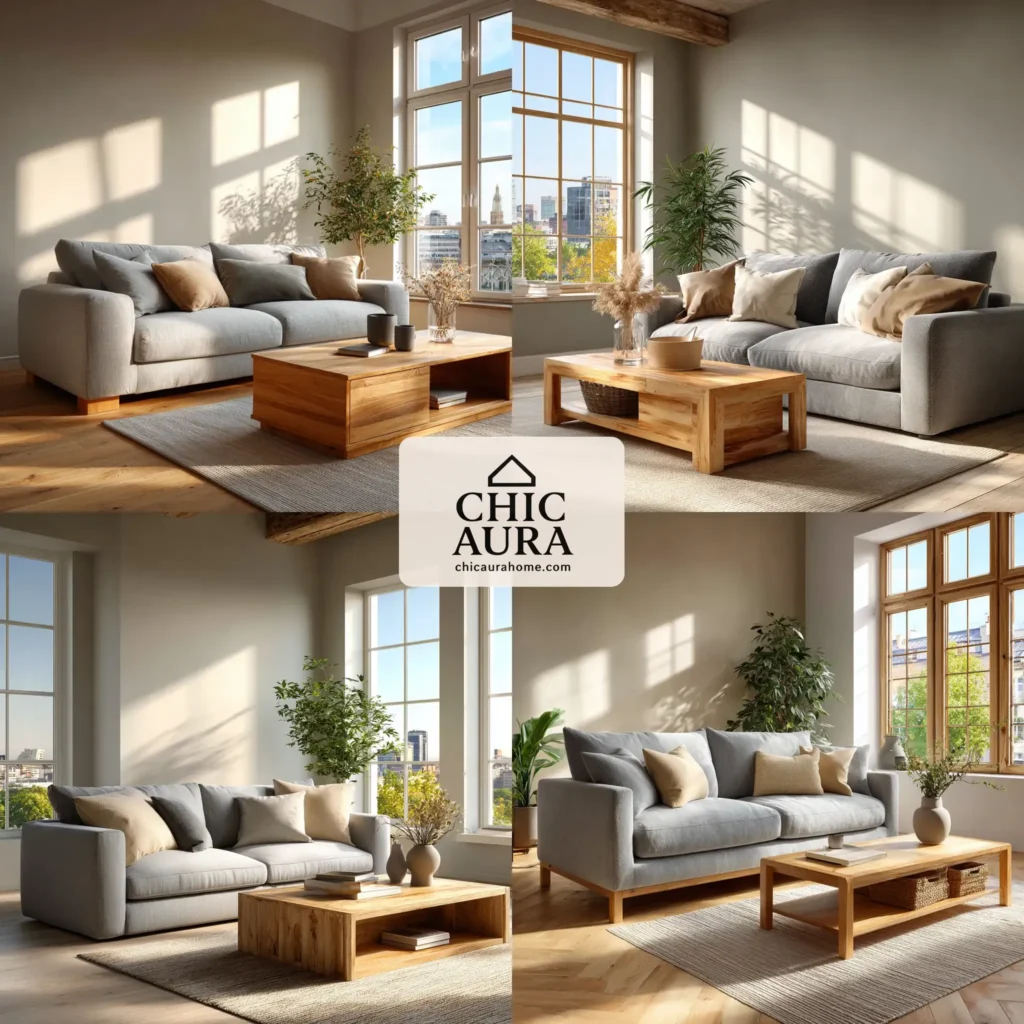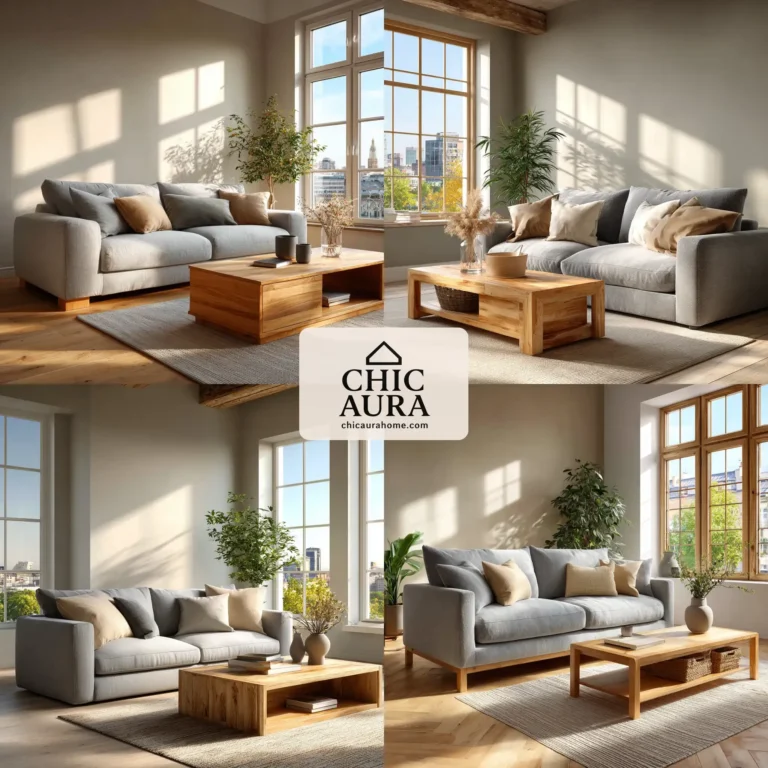Creating a Minimalist Living Room is about embracing simplicity, functionality, and beauty. This design philosophy strips away the unnecessary, leaving only what’s essential to create a serene, clutter-free space. Whether you’re redesigning your home or just looking to refresh your living area, these six ideas will inspire you to craft a minimalist living room that feels spacious, modern, and inviting.
What you’ll find in this post:
Why Choose a Minimalist Living Room?
A minimalist living room prioritizes clean lines, neutral colors, and purposeful furniture. This approach not only enhances the aesthetic appeal but also promotes a calming environment. By focusing on quality over quantity, a minimalist living room can make your space feel larger and more organized. According to The Spruce, minimalism is one of the top interior design trends for 2025, emphasizing sustainability and intentional living.
Benefits of a Minimalist Living Room
- Reduced Stress: A clutter-free space promotes mental clarity.
- Easy Maintenance: Fewer items mean less cleaning and upkeep.
- Timeless Appeal: Minimalist designs remain stylish for years.
- Versatility: Neutral palettes work with various decor styles.
Explore more styles and trends to see how minimalism fits into modern home design.
1. Embrace Neutral Color Palettes
A hallmark of a minimalist living room is its color scheme. Stick to neutral tones like white, beige, gray, or soft pastels. These colors create a calm, airy atmosphere and make the room feel larger. For instance, a white or light gray wall paired with a soft beige sofa can set the tone for elegance.
To add subtle contrast, incorporate textures like a wool throw or a linen cushion. Avoid bold patterns or bright colors, as they can disrupt the minimalist aesthetic. If you want a pop of color, use muted tones like sage green or dusty blue sparingly.
2. Choose Functional Furniture
In a minimalist living room, every piece of furniture should serve a purpose. Opt for multi-functional items, such as a coffee table with storage or a sleek sofa bed. Look for furniture with clean lines and simple designs, avoiding ornate details or excessive embellishments.
For inspiration, check out Apartment Therapy’s guide to minimalist furniture. They recommend pieces like modular sofas or foldable tables to maximize space without sacrificing style.

3. Declutter Ruthlessly
Decluttering is the cornerstone of a minimalist living room. Keep only the essentials—furniture, decor, and items you use regularly. Store away anything that doesn’t serve a purpose or enhance the aesthetic. For example, instead of multiple decorative items, choose one statement piece, like a ceramic vase or a modern sculpture.
Use storage solutions like built-in shelves or hidden compartments to keep surfaces clean. A clutter-free space not only looks better but also feels more relaxing.
4. Incorporate Natural Elements
Natural materials like wood, stone, or linen bring warmth to a minimalist living room. A wooden coffee table or a stone accent wall can add texture without overwhelming the space. Indoor plants, such as a fiddle-leaf fig or a snake plant, introduce a touch of greenery while maintaining simplicity.
For more ideas on incorporating natural elements, visit our styles and trends page for tips on blending minimalism with biophilic design.
5. Focus on Lighting
Lighting plays a crucial role in a minimalist living room. Maximize natural light with large windows or sheer curtains to create an open, airy feel. For artificial lighting, choose sleek fixtures like pendant lights or recessed lighting. Avoid overly ornate chandeliers, as they can clash with the minimalist aesthetic.
Layer your lighting with a mix of ambient, task, and accent lights. For example, a floor lamp with a simple design can provide both functionality and style.
6. Keep Decor Minimal but Impactful
In a minimalist living room, less is more when it comes to decor. Choose one or two high-quality pieces, such as a large abstract painting or a sculptural lamp, to create a focal point. Avoid overcrowding shelves or surfaces with knick-knacks.
For additional inspiration, Dwell offers excellent tips on selecting impactful decor that complements a minimalist living room.
Tips for Maintaining a Minimalist Living Room
- Regular Decluttering: Set aside time monthly to remove unnecessary items.
- Invest in Quality: Choose durable, timeless pieces over trendy, low-quality ones.
- Stick to a Color Scheme: Limit your palette to 2-3 colors for cohesion.
- Use Hidden Storage: Keep clutter out of sight with smart storage solutions.
By following these tips, your minimalist living room will remain functional and beautiful for years to come.
FAQs About Minimalist Living Rooms
What is a minimalist living room?
A minimalist living room is a space designed with simplicity, functionality, and a clutter-free aesthetic. It uses neutral colors, clean lines, and purposeful furniture to create a serene environment.
How do I start creating a minimalist living room?
Begin by decluttering your space, choosing a neutral color palette, and selecting functional furniture. Focus on quality over quantity and incorporate natural elements for warmth.
What colors work best in a minimalist living room?
Neutral tones like white, gray, beige, and soft pastels are ideal. You can add subtle accents with muted colors like sage green or dusty blue.
How can I make my minimalist living room feel cozy?
Incorporate textures like wool, linen, or wood, and add a few indoor plants. Soft lighting and minimal but impactful decor also create a warm, inviting atmosphere.
Where can I find minimalist furniture?
Retailers like IKEA, West Elm, and CB2 offer minimalist furniture. You can also explore second-hand stores for unique, high-quality pieces.
For more design inspiration, check out our styles and trends category to elevate your minimalist living room.

